|
|
|
Sort Order |
|
|
|
Items / Page
|
|
|
|
|
|
|
| Srl | Item |
| 1 |
ID:
109916
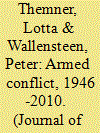

|
|
|
|
|
| Publication |
2011.
|
| Summary/Abstract |
In 2010, UCDP recorded 30 active armed conflicts (i.e. with a minimum of 25 battle-related deaths). This is a substantial reduction in relation to the 36 conflicts registered for 2009. A drop of this magnitude has only been reported four times previously in the post-1946 period. However, only in two of these instances was this part of a general downward trend. Thus no major inferences should be drawn, except perhaps that the reduction in conflicts in Africa seems to be part of a trend. At 30 in 2010, the number of active conflicts is at its lowest level since 2003. Furthermore, the number of wars (1,000 or more battle-related deaths) declined from six in 2009 to four in 2010. The most intense war in terms of fatalities was in Afghanistan. Eight of the armed conflicts listed for 2009 were not active in 2010, but during the year two new conflicts erupted - Mauritania and Tajikistan - both involving rebel groups that had previously fought in neighbouring countries. Only two peace agreements were concluded during the year. While this is one more than 2009, it is decidedly below the annual average for the post-Cold War period.
|
|
|
|
|
|
|
|
|
|
|
|
|
|
|
|
| 2 |
ID:
098418
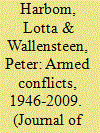

|
|
|
|
|
| Publication |
2010.
|
| Summary/Abstract |
In 2009, UCDP recorded 36 active armed conflicts, down by one from 2008. Having remained fairly stable over the past few years, the number of armed conflicts is now substantially lower than during the peak years of the early 1990s. But compared to the early years of this decade, the figure has increased by 24%. Six of the conflicts reached the level of war (more than 1,000 battle-related deaths) in 2009, up by one from 2008. No interstate conflict was recorded, but seven intrastate conflicts were internationalized, in the sense that one or both of the conflict parties received troops support from an external state. The most intense war in terms of fatalities was that in Sri Lanka. Eight of the armed conflicts listed for 2008 were not active in 2009, but during the year, one entirely new conflict erupted in Myanmar (Kokang), two were restarted by previously recorded actors in Angola (Cabinda) and in Rwanda and four previously recorded conflicts were restarted by new actors in Central African Republic, India (Bodoland), Nigeria and Yemen. Only one peace agreement was concluded during the year, which is decidedly lower than the annual average recorded for the past 20 years.
|
|
|
|
|
|
|
|
|
|
|
|
|
|
|
|
| 3 |
ID:
117019


|
|
|
|
|
| Publication |
2012.
|
| Summary/Abstract |
In 2011, the Uppsala Conflict Data Program (UCDP) recorded 37 armed conflicts with a minimum of 25 battle-related deaths. This significant increase from the 31 conflicts recorded in 2010 was primarily driven by an increase in conflicts on the African continent, and is only in part due to events tied to the Arab Spring which mostly led to other forms of violence than conventional armed conflict. The number of active conflicts still remains at a relatively low level compared to the peak years in the early 1990s, when more than 50 conflicts were active. The number of wars - conflicts leading to 1,000 or more battle-related deaths - increased to six; however, it is a considerably lower number than during the peak years of the early 1990s. For the second consecutive year, Afghanistan claimed the highest number of fatalities. Five armed conflicts listed for 2010 were not active in 2011, but during the year three new conflicts erupted - Libya, South Sudan and Sudan (Abyei) - and six conflicts already registered were restarted. Only one peace agreement was concluded during the year. Thus, the trend with low numbers of peace accords which started in 2009 continues.
|
|
|
|
|
|
|
|
|
|
|
|
|
|
|
|
| 4 |
ID:
122902
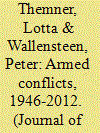

|
|
|
|
|
| Publication |
2013.
|
| Summary/Abstract |
In 2012, the Uppsala Conflict Data Program (UCDP) recorded 32 armed conflicts with a minimum of 25 battle-related deaths. This is a significant decrease from the 37 recorded in 2011. Overall, the 2000s has been the least conflict-ridden decade since the 1970s. A worrying finding, however, is that the number of internationalized intrastate conflicts continued to be at a high level for the fourth consecutive year. At six, the number of wars - conflicts leading to 1,000 or more battle-related deaths - remained the same as in 2011. In total, UCDP estimates that the conflicts that were active in 2012 caused between 37,175 (low estimate) and 60,260 (high estimate) battle-related deaths, with a best estimate of 37,941. The conflict that caused the highest number of fatalities in 2012 is the Syrian conflict, which led to between 14,830 (low) and 30,805 (high) battle-related deaths, with the best estimate being 15,055. Eleven armed conflicts listed in 2011 were not active in 2012; however, three new conflicts erupted during the year - India (Garoland), Mali and South Sudan vs. Sudan (common border) - and three previously registered conflicts were resumed by new actors. Lastly, 2012 saw an increase in the number of signed peace agreements which had been at a very low level over the past three years; four accords were concluded during the year, compared with one in 2011.
|
|
|
|
|
|
|
|
|
|
|
|
|
|
|
|
| 5 |
ID:
157724
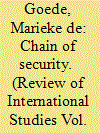

|
|
|
|
|
| Summary/Abstract |
Increasingly, private companies – including Twitter, airlines, and banks – find themselves in the frontline of fighting terrorism and other security threats, because they are obliged to mine and expel suspicious transactions. This analytical work of companies forms part of a chain, whereby transactions data are analysed, collected, reported, shared, and eventually deployed as a basis for intervention by police and prosecution. This article develops the notion of the Chain of Security in order to conceptualise the ways in which security judgements are made across public/private domains and on the basis of commercial transactions. Drawing on the work of Bruno Latour, this article understands the security chain as the set of practices whereby commercial transactions are collected, stored, transferred, and analysed, in order to arrive at security facts. Understanding the trajectory of the suspicious transaction as a series of translations across professional domains draws attention to the processes of sequencing, movement, and referral in the production of security judgements. The article uses the chain of financial suspicious transactions reporting as example to show how this research ‘thinking tool’ can work. In doing so, it aims to contribute to debates at the intersection between International Relations (IR) and Science-and-Technology Studies (STS).
|
|
|
|
|
|
|
|
|
|
|
|
|
|
|
|
| 6 |
ID:
169164


|
|
|
|
|
| Summary/Abstract |
Making sense of digital security practice requires grasping how data are put to use to compose the governing of individuals. Data need to be understood in their becoming, and in their becoming something across diverse practices. To do this, we suggest embracing two conceptual tropes that jointly articulate the being together of, and in, data compositions: composting and computing. With composting, we approach data as lively entities, and we explore the decaying and recycling processes inside Big Data security. With computing, we approach data as embodied and embodying elements, and we unpack the surveillance of ‘asylum speakers’. Together, composting and computing challenge recurrent images of data. Our conceptual composition takes sound as a necessary sensory counterpoint to popular data visions, notably in light of Ryoji Ikeda's artworks.
|
|
|
|
|
|
|
|
|
|
|
|
|
|
|
|
| 7 |
ID:
178675


|
|
|
|
|
| Summary/Abstract |
A wealth of literature argues that domestic institutions can sometimes restrain government repression. In this article, we highlight an institution tasked specifically with protecting and promoting human rights: the National Human Rights Institution (NHRI). Although common international standards exist, NHRIs exhibit substantial variation in their organization, the rights that they protect, the activities they permit, and the manner in which they appoint their members. Scholarship to date has conceptualized and measured NHRIs dichotomously; an NHRI either exists or it does not. We present data that highlights NHRI heterogeneity collected via content analysis of NHRI annual reports, NHRI websites, national constitutions, government legislation, and other sources. Using these data, we show NHRIs that can publish their findings and NHRIs that can punish offenders are each associated with less state torture. These data will allow future researchers to better explore important questions regarding NHRI origins, design, processes, and effectiveness.
|
|
|
|
|
|
|
|
|
|
|
|
|
|
|
|
| 8 |
ID:
151192


|
|
|
|
|
| Summary/Abstract |
Possibilities for crowdsourced surveillance have expanded in recent years as data uploaded to social networks can be mined, distributed, assembled, mapped, and analyzed by anyone with an uncensored internet connection. These data points are necessarily fragmented and partial, open to interpretation, and rely on algorithms for retrieval and sorting. Yet despite these limitations, they have been used to produce complex representations of space, subjects, and power relations as internet users attempt to reconstruct and investigate events while they are developing. In this article, I consider one case of crowdsourced surveillance that emerged following the detonation of two bombs at the 2013 Boston Marathon. I focus on the actions of a particular forum on reddit.com, which would exert a significant influence on the events as they unfolded. The study describes how algorithmic affordances, internet cultures, surveillance imaginaries, and visual epistemologies contributed to the structuring of thought, action, and subjectivity in the moment of the event. I use this case study as a way to examine moments of entangled political complicity and resistance, highlighting the ways in which particular surveillance practices are deployed and feed back into the event amid its unfolding.
|
|
|
|
|
|
|
|
|
|
|
|
|
|
|
|
| 9 |
ID:
128874
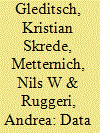

|
|
|
|
|
| Publication |
2014.
|
| Summary/Abstract |
We highlight how efforts to collect systematic data on conflict have helped foster progress in peace and conflict research. The Journal of Peace Research has played a key role in these developments, and has become a leading outlet for the new wave of disaggregated conflict data. We survey progress in the development of conflict data and how this interacts with theory development and progress in research, drawing specifically on examples from the move towards a greater focus on disaggregation and agency in conflict research. We focus on disaggregation in three specific dimensions, namely the resolution of conflict data, agency in conflict data, and the specific strategies used in conflict, and we also discuss new efforts to study conflict processes beyond the use of violence. We look ahead to new challenges in conflict research and how data developments and the emergence of 'big data' push us to think harder about types of conflict, agency, and the 'right' level of aggregation for querying data and evaluating specific theories.
|
|
|
|
|
|
|
|
|
|
|
|
|
|
|
|
| 10 |
ID:
096197
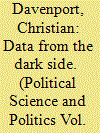

|
|
|
|
|
| Publication |
2010.
|
| Summary/Abstract |
I had interacted with professor Imari Obadele for quite some time at the National Conference of Black Political Scientists (NCOBPS). He is an elder scholar whom I knew had been politically active in the past but I was not aware of his specific affiliations or activities. At the time we first met, Obadele was only known to me as a political scientist at Prairie View. I had just begun my first job at the University of Houston a few years before. As there were not many elder black political scientists that I knew at the time, especially one interested in social movements and revolution, we immediately hit it off. It was not until a year or so after we first met and after I had published some research on the Black Panther Party (Davenport 1998a; Dahlerus and Davenport 1999; Davenport and Eads 2001), that we really started to interact.
|
|
|
|
|
|
|
|
|
|
|
|
|
|
|
|
| 11 |
ID:
146653
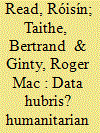

|
|
|
|
|
| Summary/Abstract |
This article looks at the promise of technology to revolutionise humanitarian action, especially in terms of the gathering and use of data. With many heralding a ‘data revolution’, the opportunities and enthusiasm for using social media and SMS data in crisis response are on the rise. The article constructs an analytical framework in order to scrutinise the three main claims made on behalf of technologically advanced humanitarian information systems: that they can access data more accurately, more quickly, and alter power relations in emancipatory ways. It does so in relation to two aspects of digital humanitarianism: visual technology and crisis mapping, and big data. The article is partly informed by a historical perspective, but also by interview and other material that suggests some of the claims made on behalf of technology are exaggerated. In particular, we argue that the enthusiasm for the data is vastly outstripped by the capacity to meaningfully analyse it. We conclude by scoping the implications of the future technological evolution of humanitarianism, in particular by examining how technology contributes to what Duffield terms ‘post-modern humanitarianism’.
|
|
|
|
|
|
|
|
|
|
|
|
|
|
|
|
| 12 |
ID:
190027
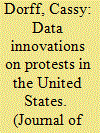

|
|
|
|
|
| Summary/Abstract |
For decades, the United States has been generally excluded from cross-national quantitative datasets on the study of collective action and political resistance. More recently, however, new data collection efforts are on the rise. These projects specifically focus on gathering granular level information about street protests and mobilizations in the United States. In this article, we conduct a rigorous exploratory data analysis of three contemporary protest datasets. These data collect information about the when, where and how of contentious politics in the United States. Our thorough data review first summarizes the key similarities and differences across the datasets. Next, we review the regional, temporal and methodological strengths and weaknesses of each dataset both individually and in contrast to one another. Last, we examine potential research applications of these data by demonstrating what these data reveal about the risks of protesting in these types of events. We conclude by offering recommendations for data use and future data collection strategies for the study of collective action.
|
|
|
|
|
|
|
|
|
|
|
|
|
|
|
|
| 13 |
ID:
157100
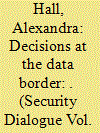

|
|
|
|
|
| Summary/Abstract |
Discussions about the legitimacy of private security companies (PSCs) in multilateral military interventions abound. This article looks at how the United States has sought to legitimize the outsourcing of security services to PSCs through performance-based contracting and performance assessments. Both mechanisms aim to demonstrate the effective provision of publicly desirable outcomes. However, the immaterial and socially constructed nature of security presents major problems for performance assessments in terms of observable and measurable outcomes. Performance has therefore given way to performativity – that is, the repetitive enactment of particular forms of behaviour and capabilities that are simply equated with security as an outcome. The implications of this development for the ways in which security has been conceptualized, implemented and experienced within US interventions have been profound. Ironically, the concern with performance has not encouraged PSCs to pay increased attention to their impacts on security environments and civilian populations, but has fostered a preoccupation with activities and measurable capabilities that can be easily assessed by government auditors.
|
|
|
|
|
|
|
|
|
|
|
|
|
|
|
|
| 14 |
ID:
169932
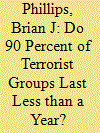

|
|
|
|
|
| Summary/Abstract |
Prominent scholars criticize terrorism research for lacking sufficient empirical testing of arguments. Interestingly, one of the most widely cited estimates in terrorism studies has not been evaluated using the many data sources now available. Rapoport’s 1992 claim, that perhaps 90 percent of terrorist groups last less than one year, has been described as part of the conventional wisdom. This estimate is frequently used to justify studies of terrorist group longevity, a substantial line of research in recent years. Is the estimate accurate? Scholars increasingly publish data sets of terrorist organizations, but no one has analyzed them collectively to see if the 90 percent claim holds up. This article examines the eight largest global data sets of terrorist group longevity, covering 1968–2013. The samples vary considerably, but the percentage of groups that do not survive beyond their first year in these relevant data sets is between 25–74 percent. Across all data sets, on average about 50 percent of terrorist organizations do not make it past their first year. There is some variation depending on group motivations, consistent with Rapoport’s “wave” theory. However, overall, terrorist organizations appear to be more durable than the conventional wisdom suggests.
|
|
|
|
|
|
|
|
|
|
|
|
|
|
|
|
| 15 |
ID:
162321


|
|
|
|
|
| Summary/Abstract |
By considering spatial relationships, this study aims to analyse to what extent per capita CO2 emissions are determined by renewable energy consumption, the share of the services sector in GDP, energy intensity and real per capita income. A panel data set composed of 173 countries over the 1990–2014 period is used to estimate an environmental Kuznets curve (EKC) augmented by neighbouring per capita income and energy intensity. Both standard and spatial forms are estimated for seven different sets of countries to assess the robustness of the results. Finally, several forecasts are performed to verify global sustainability and to provide some policy suggestions for the period 2015–2100. The empirical results indicate that (i) most areas support the standard EKC, (ii) there seems to be an inverted U-shaped relationship between neighbouring per capita income and national per capita emissions in Europe, Asia and the World as a whole, (iii) neighbouring energy intensity increases national per capita emissions, and (iv) forecasts show that economic growth will accelerate climate change. However, a steady annual growth in renewable energy consumption and a steady decrease in energy intensity, both close to 2.5%, may guarantee environmental sustainability prior to 2100.
|
|
|
|
|
|
|
|
|
|
|
|
|
|
|
|
| 16 |
ID:
187179
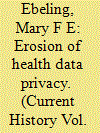

|
|
|
|
|
| Summary/Abstract |
The COVID-19 pandemic has presented lessons on using health data to improve, save, and protect lives, and the need to improve the stewardship of health privacy. Before the pandemic, the United States already had a broken health data system, fragmented and dominated by public-private partnerships in which the businesses involved sought to commercialize patient data. More than two years into the pandemic, in many respects health data privacy is even more fractured and prone to being misused to profiteer and to harm rather than help the most vulnerable. Health data is now being used by law enforcement to criminalize abortion and undocumented immigration, making reform an urgent necessity.
|
|
|
|
|
|
|
|
|
|
|
|
|
|
|
|
| 17 |
ID:
174953


|
|
|
|
|
| Summary/Abstract |
Air conditioning (AC) is a major source of household electricity consumption in Singapore and there is evidence that the efficiency of ACs could be improved substantially. Employing 45 months of energy bills and survey data and the Fixed Effects difference-in-differences estimator, we calculated a savings of 7.8% of total energy consumption after the purchase of a more efficient AC compared to an estimated expected savings of 12.6%. This suggests a rebound or take-back of savings around 38.2%. Such a less-than-100% of theoretical savings achieved is in line with other (outside Singapore) estimates and economic/behavioural theory since after purchasing a new AC, households may (i) use a lower temperature setting or (ii) use the AC longer in order to (1) fulfil (previously) unmet demand and/or (2) respond to the effective lower costs of running the AC. Our results have implications for both energy efficiency labelling policies and for Singapore's recently implemented carbon tax.
|
|
|
|
|
|
|
|
|
|
|
|
|
|
|
|
| 18 |
ID:
144783


|
|
|
|
|
| Summary/Abstract |
What do security barriers do beyond blockading or demarcating territory? This article argues for an understanding of security barriers as sociotechnical devices. It argues for a rearticulation of security barriers as more than territorial technologies or the products and producers of sovereign power. It advances the discussion of security barriers beyond what can be thought of as a ‘geopolitics of security’, where the referent object is territory, and asks that we also consider how they work with mobility as productive devices to govern people in a variety of ways. The article empirically analyses the fences of Ceuta and Melilla, the barriers of Israel’s occupation of the Palestinians, and the US counterinsurgency fence in Falluja. Building on these illustrative cases, the article argues that security barriers should be understood as products of particular modes of government and producers of particular populations through their ability to perform interruptions and capture data.
|
|
|
|
|
|
|
|
|
|
|
|
|
|
|
|
| 19 |
ID:
185674
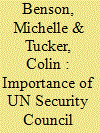

|
|
|
|
|
| Summary/Abstract |
The influence of United Nations (UN) peacekeeping in civil conflict has received important consideration in a growing body of literature. Little research, however, has focused on UN Security Council (UNSC) resolutions and their ability to determine and affect peacekeeping. New data on UNSC resolutions coded to UCDP/PRIO internal conflicts with peacekeeping operations (PKOs) is presented here. The data illustrate that resolutions vary importantly across conflicts and missions regarding their timing, sentiment toward rebel and government factions, level of action, mandates, authorized force levels, and substantive policies. Through a series of negative-binomial regressions using conflict-month replication data, we demonstrate that PKOs with both higher troops levels and a higher intensity of resolutions that condemn rebel actors experience a significant reduction one-sided rebel violence against civilians. In short, UNSC resolutions differ importantly before and during peacekeeping operations and may have an important impact on PKO effectiveness in civil conflict.
|
|
|
|
|
|
|
|
|
|
|
|
|
|
|
|
| 20 |
ID:
184205


|
|
|
|
|
| Summary/Abstract |
The premier data on leader survival focus on the violent, dramatic means by which leaders ‘exit’ office. This information, vital for many research questions, constitutes a valuable public good for the community. Yet, it provides an incomplete picture of the political rise and fall of world leaders. The burgeoning study of leaders using survival analysis requires a fine-grained understanding of not just when, but why and how leaders lose power. We cannot, for example, conclude that a leader’s exit implies a successful application of international pressure if her removal stems from pre-set constitutional laws and the immediate successor has long been considered the heir apparent. The Regular Turnover Details dataset remedies this problem. Two principal variables report information about the manner of each leader’s exit and the relationship between outgoing and incoming leaders, allowing analysts to arbitrate between exits that suggest political failure and those that don’t, identify non-political leaders (such as interim and technocratic executives), and determine whether leaders constitute heirs to power or challengers thereto.
|
|
|
|
|
|
|
|
|
|
|
|
|
|
|
|
|
|
|
|
|